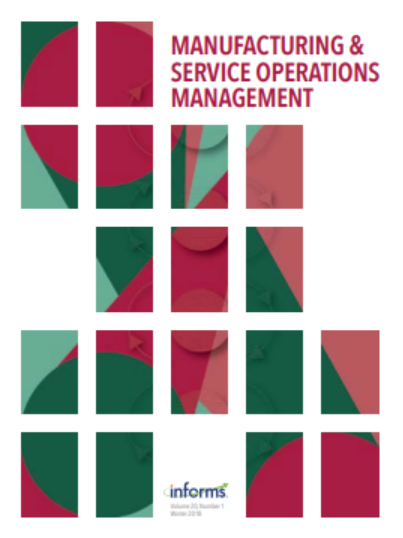部分完工作为一种非盈利策略
IF 4.8
3区 管理学
Q1 MANAGEMENT
引用次数: 2
摘要
问题定义:一些非营利组织(NPOs)面临着为受益人提供异构需求和预算约束的挑战,采用了一种创新的解决方案:为受益人提供部分完整的产品或服务。我们试图了解是什么驱使NPO选择部分完成作为设计策略,以及它如何与NPO产品或服务组合中提供的多样性水平相互作用。学术/实践相关性:虽然部分产品或服务的提供已经在非营利组织的运作中被观察到,但对于什么时候它是一个合适的策略,我们的理解是有限的——这是我们在本文中试图填补的空白。方法:我们综合了两个在不同背景下运作的非营利组织的实践,开发了一个程式化的分析模型来研究非营利组织的产品/服务完成和品种选择。结果:我们确定了何时以及在何种程度上部分完成是NPO的最佳选择。我们还描述了NPO在产品/服务种类和完成之间的预算分配结构。我们的分析揭示了受益人特征(例如,他们的需求的异质性,自我完成的能力)和非营利组织目标(例如,总利益最大化与公平)如何影响品种和完成的最佳水平。管理意义:我们提供了三个关键的观察结果。(1)部分完成不是对预算限制的妥协解决方案,但在广泛的情况下,即使在资源充足的情况下,也可能是本国专业组织的最佳策略。(2)在受益人需求高度异质或受益人具有高度自我完成能力的情况下,部分提供特别有价值。自完成能力越高,最优完成水平越低;然而,它可能导致更高或更低的最佳品种水平。(3)尽管提供不完整的产品可能会给受益人带来负担,但当非营利组织的目标中考虑到公平因素时,或者当受益人的能力更加多样化时,较低的完成水平可能是最优的。本文章由计算机程序翻译,如有差异,请以英文原文为准。
Partial Completion as a Nonprofit Strategy
Problem definition: Faced with the challenge of serving beneficiaries with heterogeneous needs and under budget constraints, some nonprofit organizations (NPOs) have adopted an innovative solution: providing partially complete products or services to beneficiaries. We seek to understand what drives an NPO’s choice of partial completion as a design strategy and how it interacts with the level of variety offered in the NPO’s product or service portfolio. Academic/practical relevance: Although partial product or service provision has been observed in the nonprofit operations, there is limited understanding of when it is an appropriate strategy—a void that we seek to fill in this paper. Methodology: We synthesize the practices of two NPOs operating in different contexts to develop a stylized analytical model to study an NPO’s product/service completion and variety choices. Results: We identify when and to what extent partial completion is optimal for an NPO. We also characterize a budget allocation structure for an NPO between product/service variety and completion. Our analysis sheds light on how beneficiary characteristics (e.g., heterogeneity of their needs, capability to self-complete) and NPO objectives (e.g., total-benefit maximization versus fairness) affect the optimal levels of variety and completion. Managerial implications: We provide three key observations. (1) Partial completion is not a compromise solution to budget limitations but can be an optimal strategy for NPOs under a wide range of circumstances, even in the presence of ample resources. (2) Partial provision is particularly valuable when beneficiary needs are highly heterogeneous, or beneficiaries have high self-completion capabilities. A higher self-completion capability generally implies a lower optimal completion level; however, it may lead to either a higher or a lower optimal variety level. (3) Although providing incomplete products may appear to burden beneficiaries, a lower completion level can be optimal when fairness is factored into an NPO’s objective or when beneficiary capabilities are more heterogeneous.
求助全文
通过发布文献求助,成功后即可免费获取论文全文。
去求助
来源期刊

M&som-Manufacturing & Service Operations Management
管理科学-运筹学与管理科学
CiteScore
9.30
自引率
12.70%
发文量
184
审稿时长
12 months
期刊介绍:
M&SOM is the INFORMS journal for operations management. The purpose of the journal is to publish high-impact manuscripts that report relevant research on important problems in operations management (OM). The field of OM is the study of the innovative or traditional processes for the design, procurement, production, delivery, and recovery of goods and services. OM research entails the control, planning, design, and improvement of these processes. This research can be prescriptive, descriptive, or predictive; however, the intent of the research is ultimately to develop some form of enduring knowledge that can lead to more efficient or effective processes for the creation and delivery of goods and services.
M&SOM encourages a variety of methodological approaches to OM research; papers may be theoretical or empirical, analytical or computational, and may be based on a range of established research disciplines. M&SOM encourages contributions in OM across the full spectrum of decision making: strategic, tactical, and operational. Furthermore, the journal supports research that examines pertinent issues at the interfaces between OM and other functional areas.
 求助内容:
求助内容: 应助结果提醒方式:
应助结果提醒方式:


